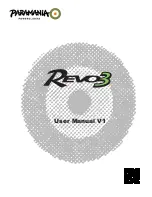
10
This method is only recommended if you have more than two line-lengths of downwind space and it is impractical to land
your kite using the front line OSR handles.
Water Relaunching the Waroo:
The Waroo has ‘built-in’ relaunch capability due to the curved shape of the wingtips and the geometry of
the VP2 bridle. With the kite’s leading edge down in the water, simply depower the kite via the trim strap,
then pull and hold either of the back lines to start the relaunch process.
The kite will taxi across the wind window, eventually rotate upwards into an upright position, and then
await relaunch, which is initiated by pulling back on the side of the bar that corresponds to the uppermost
wingtip. As the kite is relaunching off the water, be careful not to pull all the way in on the bar, which
could oversheet the kite and cause it to fall backwards into the water. Instead, as the kite begins to lift
from the water, push out on the bar a little and avoid oversheeting.
In lighter winds, it may be beneficial to use your board to create extra resistance to the pull of the kite, to
enable faster relaunch, and to speed the kite taking an upright position at the edge of the wind window.
Once in this position, simply adjust the bar and steer the kite, launching it upwards.
Hot launching:
With the kite resting on its trailing edge in the water, with its weight partly supported by the struts, it is
possible that the kite may accidentally ‘hot launch’ at some point downwind of you in the power zone
.
As
soon as the kite powers up, it is imperative that you push out on the bar and sheet out the kite, for front-
line load only (otherwise you’ll be taken for a ride). The rear lines must not have any tension until the kite
is safely in the neutral zone, which, in this case would be overhead at the zenith.
Reverse launching:
When the kite is directly downwind of you, with LE resting on the (with the wingtips closer to you and the
c-shaped center of the kite farthest away from you), you can create a reverse draft using the rear lines on
the trailing edge, which causes the kite to hover up backwards. If both rear lines are pulled with even
tension, the kite will hover up, evenly balanced. If one rear line is released a few inches, the kite will spin
around in the opposite direction and start to redirect. In this case be prepared to flip the bar and sheet-out
the kite to reduce powering up the kite in a downwind position, and crashing it back into the water.
Both of these are advanced techniques and only recommended for experienced riders.
Wind Ranges:
The suggested wind range chart is to be used as a guide. Always
know your limits, and when in doubt, rig a smaller kite, if possible.
Wind speeds may vary according to where they are taken. Always
take a wind reading more than 100m past the nearest upwind object
to get an accurate maximum reading. If flying in the mountains,
Summary of Contents for 2009 WAROO
Page 1: ...1 ...
































